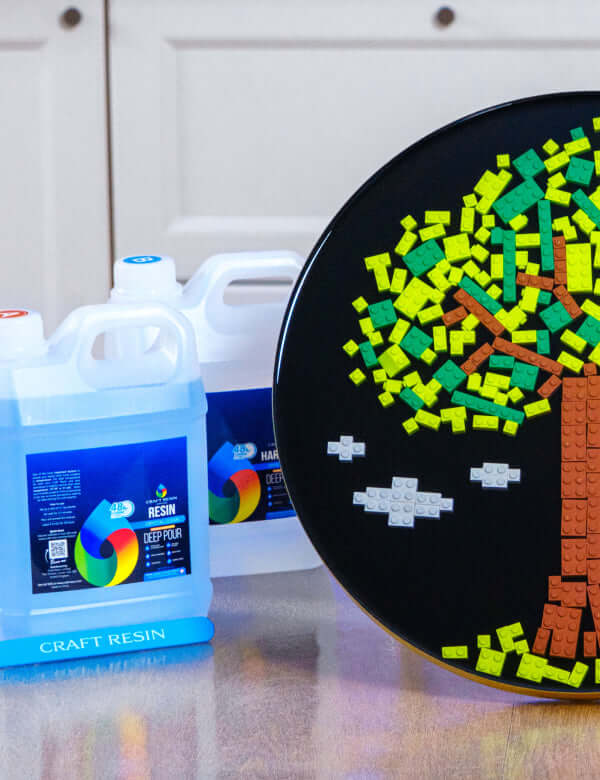Even while the temperature where you are working probably isn't as chilly as the one in the picture, it is still very important to maintain a close check on it during the curing process and when dealing with our brand's resin.
The optimal operating temperature for our brand's epoxy resin is between 21 and 24 degrees Celsius (70 and 75 degrees Fahrenheit). Please ensure that the temperature stays below these levels, as we want you to be able to handle the masterpieces you make with epoxy resin gallon kit.

There are a few things that may go wrong when the temperature drops:
- Not curing at all, or taking a much longer time to cure,
- Micro-bubbles (resin that has a foggy, misty look)
- Ripples
- Separations.
Any of these conditions call for an immediate examination of body temperature. The following temperature-related factors need your attention:
- The ambient temperature at work
- Your resin's or hardener's temperature
- Your curing area's temperature (through the whole curing process)
- The substrate's or mold's temperature
Let's examine them more closely, and then I'll explain why it's so important to carefully check them and get them exactly right while dealing with epoxy glue...
Your workspace temperature:
Maintain a temperature of 21-24 degrees Celsius (70-75 degrees Fahrenheit) in your working and drying room during the first 24 hours of most projects. Keep the area warm if the curing time for your project will be more than 24 hours.
You must maintain the room at or above these temperatures throughout the curing period, with no dips below them.
Problems may arise if you successfully maintain a stable body temperature throughout the day, but your temperature drops at night. Rippling or dimples in the resin project may indicate the temperature dropped while it was curing.
We know it's not easy to keep the room at a consistent temperature for a whole day, but it's necessary for the success of your resin projects.
Turn on the heaters in your workspace or the heating system when working with resin. Turning off individual radiators in unused spaces may be an option. The resin chamber may be heated with a storage or an electric heater.
If your workspace is already warm enough, a heat mat and a big Tupperware container may be all you need to maintain the resin at the proper curing temperature while you work on a few smaller resin things. This may not be effective if ambient temperatures are much lower than the heat mat's operating range.

The temperature of your resin/hardener:
Maintain your resin at a temperature of around 70F (21C).
In this range, Craft Resin is completely clear, fluid, and easy to work with, all of which combine to make pouring a breeze. When resin is subjected to cold, microscopic bubbles grow inside it, making the substance appear hazy or muddy.
To prevent the formation of air bubbles, which cannot be eliminated after the resin has been poured, clear, glass-like products need an epoxy resin dye mix that has been heated. On the other hand, a heat torch may be used to pop larger bubbles that have formed on the surface.
It is more difficult to work with resin kept in a cold climate because it is thicker, more difficult to spread out and generally needs to self-level. These characteristics may lead to issues such as a ripple effect on the surface or uneven areas and holes of resin in your work.
To prevent these issues, warm your resin and hardener before using them. You may place them in warm water in a sink or next to a heater for a few hours before using them. If you wish to use this strategy, keep the lids on the bottles at all times and fill the sink to a lower level than the tops of the bottles. Any moisture that gets into your bottles might cause issues.
After filling the bowl with water, you should let the beans soak for ten to fifteen minutes. The water shouldn't be piping hot; rather, it should be warm. You may not know what works best for you until you experiment with different timings and temperatures for your soaks.
After being cleaned with water, the bottles must be patted down with a towel until completely dry. When the caps are removed, there is a possibility that water will get into the bottles. After doing so, you can measure and pour your resin with precision.
Your curing area (for the whole time the curing is taking place):
The temperature of your workplace has to be maintained between 21 and 24 degrees Celsius (or 70 and 75 degrees Fahrenheit) not only while you are working on your project but also throughout the time that your work is curing.
If the temperature falls below this during this period, then problems with curing may arise; for example, your work may not entirely cure, or it may develop ripples or dimples.

That which serves as your foundation, basis, or mold:
If you have established that all of your temps are set to warm but that your base, substrate, or molds are cold, this might create temperature shock when the resin mix is subsequently poured over them. Rippling and separation are two problems that might result from this.
Before you pour the heated resin over the molds or artwork, ensure they have acclimatized to the warmer environment by spending at least a couple of hours there beforehand. Even while sitting in a warm area, the temperature of a base may still be lower than the room's temperature. If you are concerned that they are still uncomfortable to touch despite being in a warm environment, consider placing them near or on a radiator, provided that it is not too hot, or put them on a heating pad before using them.
This winter, it won't just be you who'll want to keep warm; your resin projects will, too.
Team Craft Resin







